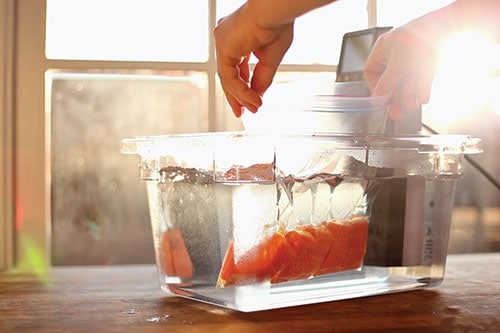
French for "under pressure," sous vide is a method of cooking in vacuum-sealed pouches at precise temperatures. While sous vide cooking has been around since the late 1960s, it has gained popularity over the last two decades in American restaurants and, more recently, has been working its way into home kitchens. Meanwhile, many national restaurant chains, cruise ships, hotels, colleges and universities, and retail foodservice operations are jumping on the sous vide bandwagon.
At the heart of sous vide cooking is exacting control, and the allure of this method is perfectly cooked food. The water bath temperature is set at the desired internal temperature of the finished product, and the process is complete when the food hits that exact degree — no more, no less.
Temperatures for sous vide cooking range from 115 degrees to 190 degrees Fahrenheit and cooking times can be from minutes (for certain vegetables) up to 48 hours for tough cuts of meat.
Another notable benefit is enhanced flavors since all of the juices, vapors, herbs and oils stay in the sealed pouch. Vacuum-sealing the pouch before cooking further develops flavor components.
This style of cooking needs no added fat, and because of the intense flavors, little salt is needed. Of course, cooking meats in a sealed plastic pouch submerged in water eliminates the Maillard reaction that occurs with browning, so some cooks will sear the cooked meat prior to serving. Cooking at lower temperatures and in a sealed bag reduces moisture loss and product shrinkage, resulting in a higher product yield. And because of its system of packaging and storage, little food is wasted in sous vide cooking.
Another advantage to this method is reliability, particularly in a facility where consistency is critical. Sous vide ensures culinary quality and consistency no matter who places the pouch in the water bath. For example, health-care foodservice operations with room service or restaurant-style menus could benefit from adopting this cooking method to enhance consistency and accommodate menu flexibility, especially for individual servings.
The two basic components of a sous vide cooking set-up are sealing a thin layer of food in a heat-stable, food-grade plastic pouch — removing air improves heat transfer and also allows for various texture manipulations — and inserting it into a temperature-controlled water bath.
Commercial or professional foodservice operations use a chamber vacuum-packing machine to seal food, while many home cooks use home-style food sealers, which can do the job but do not achieve the same level of vacuum pressure. Also, it is recommended to use pouches designed for sous vide; some home cooks use food storage bags, but these are not usually graded for cooking and may leak.
The pouches are cooked in a temperature-controlled unit. Professional kitchens use a thermal immersion circulator to heat and circulate the water. Convection steam ovens also can be used and allow for larger volumes of food to be cooked, but they lack the precision of a circulating water bath and require more monitoring.
In addition to home mode sous vide appliances, home cooks can use a rice cooker, slow cooker or counter-top roaster equipped with a PID controller (a device to maintain the temperature of the water).
The most important aspect of sous vide cooking is food safety, and two factors — extended cooking time in the danger zone and reduced oxygen packaging — necessitate special vigilance with food handling. Food safety consultant Jamie Stamey, MS, RDN, LDN, CP-FS, suggests focusing on food safety basics: proper food handling, clean surfaces, cooking foods to safe temperatures, cooling foods efficiently and proper storage.
Meanwhile, as the foodservice industry and casual culinarians alike explore sous vide, the future may hold even more creative applications for precision cooking.
